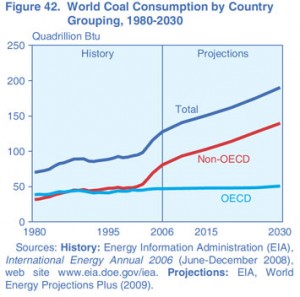 Forecast & Outlook: Coal is the world’s fastest growing source of energy and leading fuel source associated with carbon emissions. There is a two-fold path to rethinking our relationship with coal’s carbon molecules based on ‘Cathedral Thinking‘ and ‘Manhattan Project‘ strategies. The end result and legacy we might leave future generations is a new capacity to better deal with carbon molecules through nanostructured materials and bio-energy technology solutions that master the fundamental molecular interactions of carbon, hydrogen and oxygen.
Forecast & Outlook: Coal is the world’s fastest growing source of energy and leading fuel source associated with carbon emissions. There is a two-fold path to rethinking our relationship with coal’s carbon molecules based on ‘Cathedral Thinking‘ and ‘Manhattan Project‘ strategies. The end result and legacy we might leave future generations is a new capacity to better deal with carbon molecules through nanostructured materials and bio-energy technology solutions that master the fundamental molecular interactions of carbon, hydrogen and oxygen.
Part One: Cathedral Thinking
Duke Energy CEO Jim Rogers is the utility sector’s (coal’s biggest consumer) leading voice associated with the long term approach of Cathedral Thinking. Rogers has been refining his public ‘building cathedrals’ message since a 2007 commencement speech, but was most targeted at energy entrepreneurs during an MIT event in 2008 .
A Cathedral Thinking approach to coal begins with the vision and commitment to realizing a low carbon emission future, then developing the technology strategies and regulatory framework to support efforts that will likely occur across generations of innovators. Rogers’ guidelines for framing this issue? ‘We need a sense of urgency, but not a sense of panic…a sense of hope, not a sense of fear… politics of possibilities, not the politics of punishment‘.
Rogers is clear that technology will play the critical role in achieving this vision of a low carbon future, but falls short of detailed blueprint or roadmap. So, if I could propose a few broadly accepted enabling ideas that support a new relationship with carbon.
‘Cathedral Thinking’ Foundations: Geo, Bio and Nano Engineering
Geo-Engineering capacities to support carbon sequestration via capture and storage. Bio-Engineering capacities based on carbon-fed bioreactors that tap the molecular powerplants inside algae and bacteria to assemble bio-hydrocarbons. And Nano-scale Materials Engineering capacities using nanotechnology inspired membranes and catalysts that enable coal gasification and/or chemical processes (Fischer-Tropsch) that convert carbon into synthetic fuels. Together, these are the long-term enablers of reducing carbon emissions from coal.
In Part Two, we will look at a supplemental strategy to ‘Cathedral Thinking’ that brings a higher sense of immediacy via disruptive energy systems supported by a ‘Manhattan Project‘ style effort towards carbon science and engineering.
How might we accelerate changes by shifting investments to basic science and applied engineering of biological and materials technologies that could be more disruptive in giving humanity the knowledge and know-how of mastering the molecular interactions of carbon to avoid CO2 atmospheric release?!
MIT World talk titled:
Building Technology, Talent and Policy Bridges to a Low-Carbon Future (April 12, 2008)
[Video [47 minutes]
Newsweek article: Cathedral Thinking Interview by Fareed Zakira
[Reprinted with permission via Duke Energy]
Related Blog Post by Jim Meredith
Duke Energy – Executive Viewpoints
Build Your Own Cathedral Queens University Commencement Speech Transcript [PDF]
Coal: Some Inconvenient Truth [PDF] by Geologist David Hughes
Articles from The Energy Roadmap.com
